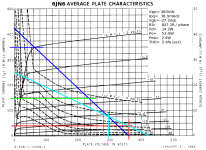Hey guys, question. I searched for it and couldn't find anything so apologies if this is a stupid question.
Basically I'm interested in increasing the power output of Pete Millett's Engineer's Amplifier from ~20 Watts to 40-50 Watts to drive a set of 4-5 ohm Magnepan MMGs.
I'm rather new to the tube world (solid state guy mostly) and according to Pete, I need to raise the B+ and lower the plate to plate load impedance. What I'm looking for is how to do this correctly (I can probably figure this out, but more than likely to the demise of my speakers, the amplifier, several otherwise perfectly usable tubes, and likely my source too).
So what wisdom can you send my way in accomplishing this task, and what things I might need to be concerned about both in increasing the output power (while minimizing the distortion and noise as much as possible) and also driving a 4 ohm speaker with a tube amp.
Thanks for the help guys
Basically I'm interested in increasing the power output of Pete Millett's Engineer's Amplifier from ~20 Watts to 40-50 Watts to drive a set of 4-5 ohm Magnepan MMGs.
I'm rather new to the tube world (solid state guy mostly) and according to Pete, I need to raise the B+ and lower the plate to plate load impedance. What I'm looking for is how to do this correctly (I can probably figure this out, but more than likely to the demise of my speakers, the amplifier, several otherwise perfectly usable tubes, and likely my source too).
So what wisdom can you send my way in accomplishing this task, and what things I might need to be concerned about both in increasing the output power (while minimizing the distortion and noise as much as possible) and also driving a 4 ohm speaker with a tube amp.
Thanks for the help guys
First, realize that the power difference you're talking about represents only about 3dB or so difference in loudness- that's noticeable but not exactly profound.
In any case, what you'll need to do is use sweep tubes with higher plate dissipation (any of the tubes in the 30W class should work OK). Then increase plate voltage and reduce plate-to-plate load impedance. You could accomplish the latter by connecting your 4R speaker across the 8R tap.
I've been experimenting down the same lines- I changed the output tubes to 6LF6, increased the B+ to 450V, and reduced the p-p load to 4k. That got me a solid 60W. Next step is to drop the load to 1250R and increase the B+ to 600V...
In any case, what you'll need to do is use sweep tubes with higher plate dissipation (any of the tubes in the 30W class should work OK). Then increase plate voltage and reduce plate-to-plate load impedance. You could accomplish the latter by connecting your 4R speaker across the 8R tap.
I've been experimenting down the same lines- I changed the output tubes to 6LF6, increased the B+ to 450V, and reduced the p-p load to 4k. That got me a solid 60W. Next step is to drop the load to 1250R and increase the B+ to 600V...
Basically I'm interested in increasing the power output of Pete Millett's Engineer's Amplifier from ~20 Watts to 40-50 Watts to drive a set of 4-5 ohm Magnepan MMGs.
You'll need a new loadline, but it can be done. I would also consider ditching the local NFB, at least until after you've listened to it without NFB before deciding what's needed in that regard. After doing a project with 6BQ6GTBs, it turned out that these really didn't need local NFB since they didn't produce the nasty high order harmonics. Being that the 6JN6 is also a horizontal deflection type, it may not either.
Attachments
Hey guys, question. I searched for it and couldn't find anything so apologies if this is a stupid question.
Pete introduced this amp to the diyAudio community in this thread.
http://www.diyaudio.com/forums/tubes-valves/151206-posted-new-p-p-power-amp-design.html
It has been discussed pretty good there. There are 192 posts. Several posters discuss their methods for obtaining a bit more power. My "red board" now makes 125 watts per channel, and I am not done with it. 150 WPC should be easy, maybe more.
Post #149 demonstrates that the little 6JN6's respond well to a lower load impedance and more voltage. I used a 6600 ohm output transformer because I have them. You will get 50 WPC with a 450 volt power supply, and more power with more voltage.
In post #168 I plugged in some bigger tubes and tested further. I used 6HF5's (again because I have some) and obtained 125 WPC with a 3300 ohm load and a 520 volt power supply. More testing will happen, but right now the amp and I are 1200 miles apart.
I left the power supply components off of my board and used external supplies for all testing. I do this with all of my amp designs (or major modifications). Once I decide on what voltages and currents I want in the final amplifier I will either modify the on board supply or design an off board supply.
As with any amplifier (tube or solid state) the further you deviate from the original designers intended power output, the more modifications are required. As I found out (and I know better) you need higher voltage electrolytics to go much beyond 50 WPC.
would also consider ditching the local NFB, at least until after you've listened to it without NFB before deciding what's needed in that regard
Try it both ways, but I far preferred the local NFB with zero GNFB in every test.
Picture of board in post #170
Last edited:
- Status
- This old topic is closed. If you want to reopen this topic, contact a moderator using the "Report Post" button.
